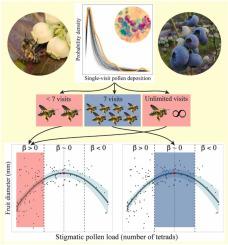当前位置:
X-MOL 学术
›
Agric. Ecosyst. Environ.
›
论文详情
Our official English website, www.x-mol.net, welcomes your
feedback! (Note: you will need to create a separate account there.)
Optimal pollination thresholds to maximize blueberry production
Agriculture, Ecosystems & Environment ( IF 6.0 ) Pub Date : 2024-02-02 , DOI: 10.1016/j.agee.2024.108903 Andrés F. Ramírez-Mejía , Natacha P. Chacoff , Silvia B. Lomáscolo , Ben A. Woodcock , Reto Schmucki , Pedro G. Blendinger
Agriculture, Ecosystems & Environment ( IF 6.0 ) Pub Date : 2024-02-02 , DOI: 10.1016/j.agee.2024.108903 Andrés F. Ramírez-Mejía , Natacha P. Chacoff , Silvia B. Lomáscolo , Ben A. Woodcock , Reto Schmucki , Pedro G. Blendinger

|
Pollination management for highbush blueberry crops ( spp.) generally depends on beehives stocked at variable densities, with little consideration given to optimal pollination levels dictated by the mating system of the crop. This approach limits our capability to accurately forecast the consequences of animal pollination on crop productivity and can result in pollination shortfalls. Using experimental and observational data, we estimated optimal pollination thresholds for blueberry crops that maximize fruit diameter. We manipulated stigmatic pollen loads and used Bayesian models to evaluate the effects on fruit diameter. In this way, we were able to define thresholds for deficient, optimal and supraoptimal pollen deposition in blueberries. These thresholds were then evaluated under field conditions in blueberry farms, and used simulations to estimate the minimum number of honeybee visits required for optimal blueberry pollen deposition. A quadratic relationship described fruit diameter in response to stigmatic pollen load, with optimal pollen deposition peaking at 192 pollen tetrads and ranging between 112 and 274. Our simulations showed that a flower visitation rate guaranteeing, on average, six to seven honeybee visits per flower (i.e. flower visitation rate of 0.6 visits per 100 flowers h) would result in 60% of the plant flowers receiving optimum stigmatic pollen deposition. Higher numbers of honeybee visits increased the probability that blueberry stigmatic pollen loads were below the optimum and the probability that smaller berries were produced. We show that adverse pollination scenarios in blueberries can occur through different pathways, either because of a deficit or an excess of pollination that directly impacts the quality of the fruits produced. By identifying thresholds, we provide a pragmatic basis for adaptive management of honeybees based on average visitation rates that are most suitable for growers to manipulate. Our study provides new insights into the mechanisms behind pollination, fruit production, and the contribution of honeybee to blueberry crops. We highlight that systematic pollination management through flower visitation monitoring and clear optimal pollination targets can help prevent detrimental pollination scenarios.
中文翻译:

最佳授粉阈值可最大限度提高蓝莓产量
高丛蓝莓作物 (spp.) 的授粉管理通常取决于以不同密度储存的蜂箱,很少考虑作物交配系统决定的最佳授粉水平。这种方法限制了我们准确预测动物授粉对作物生产力的影响的能力,并可能导致授粉不足。利用实验和观察数据,我们估计了蓝莓作物的最佳授粉阈值,使果实直径最大化。我们操纵柱头花粉量并使用贝叶斯模型来评估对果实直径的影响。通过这种方式,我们能够定义蓝莓花粉沉积不足、最佳和超最佳的阈值。然后在蓝莓农场的现场条件下评估这些阈值,并使用模拟来估计最佳蓝莓花粉沉积所需的蜜蜂访问的最小数量。二次关系描述了果实直径与柱头花粉负载的关系,最佳花粉沉积在 192 个花粉四分体处达到峰值,范围在 112 到 274 之间。我们的模拟表明,花访问率保证平均每朵花有 6 到 7 只蜜蜂访问(即每100朵花0.6次访问的花访问率(h)将导致60%的植物花接受最佳柱头花粉沉积。蜜蜂访问次数增多会增加蓝莓柱头花粉量低于最佳值的可能性,并增加产生较小浆果的可能性。我们表明,蓝莓的不良授粉情况可能通过不同的途径发生,无论是授粉不足还是授粉过多,都会直接影响所产果实的质量。通过确定阈值,我们根据最适合种植者操纵的平均访问率,为蜜蜂的适应性管理提供了务实的基础。我们的研究为授粉、水果生产以及蜜蜂对蓝莓作物的贡献背后的机制提供了新的见解。我们强调,通过花朵访问监测和明确的最佳授粉目标进行系统授粉管理有助于防止有害的授粉情况。
更新日期:2024-02-02
中文翻译:

最佳授粉阈值可最大限度提高蓝莓产量
高丛蓝莓作物 (spp.) 的授粉管理通常取决于以不同密度储存的蜂箱,很少考虑作物交配系统决定的最佳授粉水平。这种方法限制了我们准确预测动物授粉对作物生产力的影响的能力,并可能导致授粉不足。利用实验和观察数据,我们估计了蓝莓作物的最佳授粉阈值,使果实直径最大化。我们操纵柱头花粉量并使用贝叶斯模型来评估对果实直径的影响。通过这种方式,我们能够定义蓝莓花粉沉积不足、最佳和超最佳的阈值。然后在蓝莓农场的现场条件下评估这些阈值,并使用模拟来估计最佳蓝莓花粉沉积所需的蜜蜂访问的最小数量。二次关系描述了果实直径与柱头花粉负载的关系,最佳花粉沉积在 192 个花粉四分体处达到峰值,范围在 112 到 274 之间。我们的模拟表明,花访问率保证平均每朵花有 6 到 7 只蜜蜂访问(即每100朵花0.6次访问的花访问率(h)将导致60%的植物花接受最佳柱头花粉沉积。蜜蜂访问次数增多会增加蓝莓柱头花粉量低于最佳值的可能性,并增加产生较小浆果的可能性。我们表明,蓝莓的不良授粉情况可能通过不同的途径发生,无论是授粉不足还是授粉过多,都会直接影响所产果实的质量。通过确定阈值,我们根据最适合种植者操纵的平均访问率,为蜜蜂的适应性管理提供了务实的基础。我们的研究为授粉、水果生产以及蜜蜂对蓝莓作物的贡献背后的机制提供了新的见解。我们强调,通过花朵访问监测和明确的最佳授粉目标进行系统授粉管理有助于防止有害的授粉情况。


















































 京公网安备 11010802027423号
京公网安备 11010802027423号